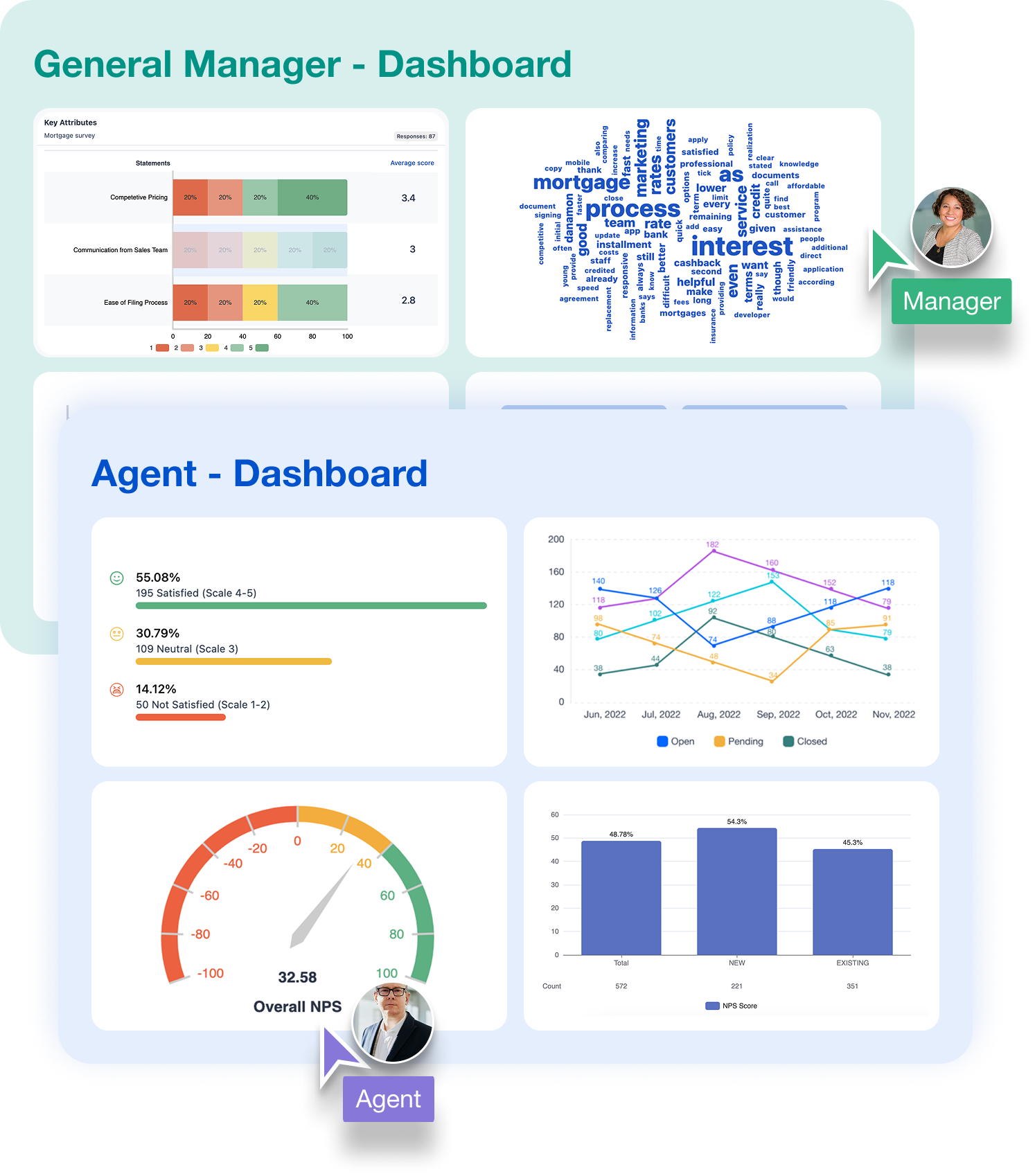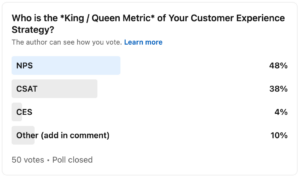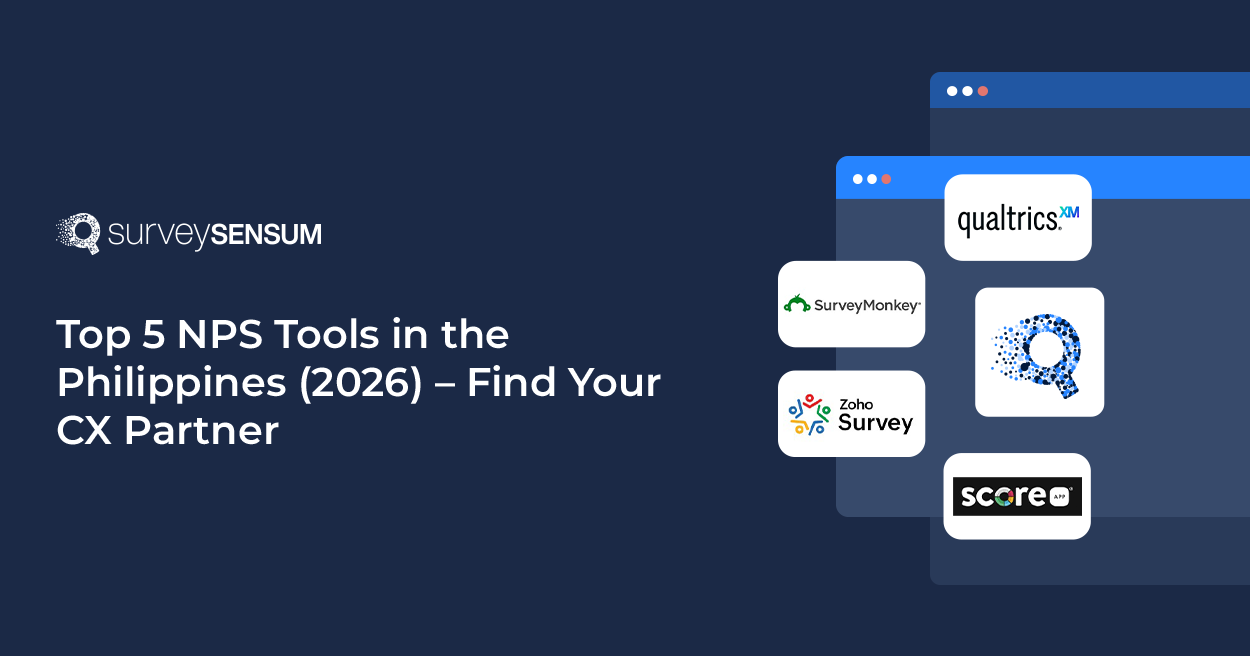

Why Voice of Customer Matters (& How To Do It Right)

Why Does Listening to the Voice of the Customer Matter?What do your customers really think about your brand?
Are they satisfied? Frustrated? Or just indifferent?
Here’s the thing – 77% of customers have a more favourable view of brands that ask for and accept customer feedback. That’s where Voice of Customer (VoC) programs come in! But what is VOC, why is it crucial, and how can you leverage it to improve customer satisfaction and business growth? Let’s dive in!
What is Voice of Customer (VoC)?
Voice of Customer (VoC) refers to the process of capturing, analyzing, and acting on customer feedback to understand their needs, preferences, and expectations. It helps businesses gain insights into what customers truly think about their products, services, or overall experience.
Let’s understand this in a bit more detail!
Why Does Listening to the Voice of the Customer Matter?
Today, most business communication is virtual. Businesses rarely have the opportunity to meet and greet customers to deliver personalized customer support. That can lead to unintended communication breakdown.
By listening to the Voice of the Customer, you can make data-driven decisions that directly improve customer experience.
Here are some more benefits of listening to the voice of the customer.
1. Integrate Insights From Customers Into Decision-Making
Every business wants to listen to its customers and take corrective measures. Listening to the Voice of Customers gives you proper insights into what customers feel and sets the management to think in that direction. It could lead to a new product release, a feature update, or even a pricing change that can make the business more appealing to customers.
Brand Example: Slack introduced threaded replies and workflow builder based on user feedback. Customers requested more structured communication, and Slack acted by building features that directly aligned with those insights, driving user satisfaction and retention.
2. Understand Customer Expectations Better
Irrespective of the good intentions that the business has, it may not be able to deliver what the customer is expecting. This could be because the business is unaware of the real customer expectations.
The Voice of Customers can be used to understand user and client expectations better.
Brand Example: When Airbnb noticed users expecting hotel-like services (cleanliness, consistency), they rolled out the “Airbnb Plus” program, featuring homes vetted for quality, amenities, and service.
3. Reduce Customer Churn
Customer churn is often the result of unmet expectations. When businesses fail to listen to their customers, frustration builds, leading them to switch to competitors. However, a VoC program enables you to gather real-time feedback across multiple channels – surveys, reviews, social media, and direct interactions – to identify pain points and take proactive action.
The impact? Companies that reduce churn by just 5% can increase profitability by 25-95%.
4. Enhancing Customer Experience
Ever wondered why some companies have loyal customers while others struggle with retention? It all comes down to the customer experience.
A VoC program helps businesses analyze customer feedback across different touchpoints – website, support, in-store visits, mobile app, and more – to identify pain points and fix them before they drive customers away.
Brand Example: Amazon leverages VoC extensively by collecting reviews, ratings, chat feedback, and post-purchase surveys. This data helps them refine everything from delivery times to Alexa voice commands, creating the seamless, customer-obsessed experience they’re known for.
5. Identify Positive Reviews That Can Be Promoted
Positive reviews and customer testimonials are valuable, but not always easy to gather. However, with a VoC program, you can consolidate and identify positive feedback across multiple channels – surveys, social media, reviews, and direct feedback.
These testimonials can then be strategically showcased on websites, landing pages, app stores, and other key touchpoints where potential customers seek validation and can increase conversions by 270%.
6. Encourage Customers For Co-creation
The best products aren’t always built in boardrooms – they’re shaped by the people who use them. Customers know firsthand what works, what doesn’t, and what could make a product better. In fact, 77% of consumers prefer brands that actively invite and act on customer feedback. A VoC program helps you tap into these insights, encouraging customers to co-create and contribute ideas that lead to better products and services.
7. Build Social Proof With Positive Reviews
Positive reviews and customer testimonials are hard to come by. The voice of the customer creates a consolidated channel where such positive reviews and testimonials can be found.
Such reviews can be used on your website, landing pages, mobile app download pages, and other destinations where customer buy-in may have to be sought.
Brand Example: Dropbox amplified its customer base by promoting positive testimonials and reviews on landing pages and during its referral campaign. These stories built social proof and helped them scale from a niche product to a global essential.
8. Improves Customer Service
Like lifelong learning, there is no end to customer service improvement. The voice of the customer brings to the surface untold problems and challenges your customers could be facing. It acts as a channel to vent their frustration about something not working properly or a department or service that needs improvement.
Take, for instance, a retail store like IKEA, where customers will find it difficult to locate products. They need an assistant to locate it or a guide to take them there. The voice of the customer can expose such intricate shortcomings in customer service that normal customer feedback systems may not provide.
9. Gives New Meaning to Brand Awareness
A brand is different from an ordinary business for the additional value it provides. For instance, Apple. There are countless other computing device manufacturers. But Apple stands out from all of them for its immense value in design, features, and customer service. It literally anticipates what customers expect from them and delivers on it.
For businesses that aspire to become the Apple of their industry or sector, the voice of customers helps them with insights into customer behavior. This also enables them to foresee customers’ demands for the near future so that they can start working on it in advance.
Discover the true voice of your customers with SurveySensum’s AI-powered analysis. Find hidden insights, address pain points, and deliver experiences that stand out!
Let’s now focus on how to build a VoC program that drives results.
How to Build a Successful Voice of Customer Program?
A well-executed VoC program is the key to unlocking these benefits.
But what exactly makes a VoC program successful?
It’s not just about gathering feedback but about turning it into meaningful action.
Let’s dive into the essential steps to building a robust, customer-centric VoC program that delivers real results.
1. Set Clear Objectives: Know Your Why
Before jumping into customer surveys or feedback forms, ask yourself: What are you trying to achieve?
Your goals will shape the entire program. Are you aiming to:
- Improve customer satisfaction?
- Enhance product features?
- Reduce churn?
- Boost customer loyalty?
Without clear objectives, you risk drowning in data without direction.
For example, if your goal is to reduce customer complaints, you’ll want to focus on identifying pain points in the customer support experience. On the other hand, if you’re launching a new product, you’ll want feedback on features and usability.
2. Map the Customer Journey: What Touchpoint Matters the Most?
Customers interact with your business across multiple touchpoints – from browsing your website to contacting customer support or engaging on social media. Mapping out these touchpoints helps you understand where to gather feedback and identify critical moments that influence customer satisfaction. Key touchpoints include:
- Pre-purchase research (website, reviews, ads)
- Purchase experience (checkout process, pricing clarity)
- Post-purchase support (customer service, returns)
- Ongoing engagement (loyalty programs, social media interactions)
By understanding the customer’s journey, you can pinpoint when and where to collect the most valuable feedback.
For example, if you run an e-commerce store and customers are abandoning their carts at a high rate. Without mapping the journey, you might guess the issue is product pricing. But by collecting feedback specifically at the checkout touchpoint, you discover the real problem: unexpected shipping costs at checkout.
3. Select the Right Data Collection Methods: One Size Doesn’t Fit All
Gathering feedback isn’t just about sending surveys. Different methods provide different insights. A well-rounded VoC program leverages multiple channels, including:
Direct Feedback
- Surveys (Net Promoter Score, Customer Satisfaction Score, etc.)
- Customer interviews
- Focus groups
Indirect Feedback
- Social media monitoring
- Online reviews
- Customer support interactions
- Behavioral Data
- Website analytics (click patterns, heat maps)
- Purchase history
- Product usage data
Combining qualitative and quantitative feedback provides a more complete picture of customer sentiment and behavior.
For example, suppose you only send out a quarterly survey to measure customer satisfaction. You might miss real-time frustrations customers share on Twitter about a new product update. But by direct feedback via surveys with social listening, you get both the structured scores and the unfiltered emotions, giving you a true 360° view of customer sentiment.
4. Centralize and Integrate Feedback: Break Down the Silos
A common mistake businesses make is collecting feedback in isolated departments. Marketing runs a survey, customer support tracks complaints, and product teams gather user feedback – none of which is shared across teams.
To truly understand your customers, you need to centralize this data. A CRM system or VoC analytics platform can help integrate data from different sources, giving you a unified view of customer sentiment and trends.
For example, let’s say your customer support team notices rising complaints about a new feature, but your product team, unaware of this feedback, continues rolling out updates that worsen the issue. If all teams had access to centralized feedback, the product team could react faster, preventing churn and boosting customer satisfaction.
5. Analyze the Data: Turn Feedback into Actionable Insights
Data without analysis is just noise. The goal is to identify patterns, trends, and root causes behind customer behavior.
Key analysis techniques include:
- Sentiment analysis: Using AI Analysis tools to detect emotions and attitudes in customer feedback.
- Trend identification: Spotting recurring issues or emerging preferences over time.
- Customer segmentation: Analyzing feedback based on demographics, behavior, or customer type.
- Root cause analysis: Identifying the underlying reasons behind complaints or negative reviews.

SurveySensum’s AI-powered text and sentiment analysis software works by automatically tagging and subtagging feedback into relevant categories based on relevant keywords and themes. While automation is there, you can also train the AI models to improve accuracy and customize categorization to fit specific business needs. The AI analyzes up to 10,000 open-ended responses in just 5 seconds with 99% accuracy, allowing businesses to quickly identify key trends and sentiments without manual effort.
Don’t let valuable feedback get buried in spreadsheets. With SurveySensum’s AI-powered tools, instantly detect sentiment, uncover hidden themes, and act on what matters most!
6. Take Action: Close the Feedback Loop

Here’s where many VoC programs fall short: they collect feedback but fail to act on it.
To drive real change:
- Prioritize issues based on impact and feasibility.
- Assign ownership to relevant teams (e.g., product development, customer support, marketing).
- Implement solutions and track results.
- Communicate changes back to customers.

With SurveySensum’s closed-loop ticketing system, you can automatically create tickets from negative feedback, assign/escalate to the right teams, and visualize the progress with the dashboard to ensure timely follow-ups.
7. Measure Success and Continuously Improve
VoC programs aren’t “set it and forget it.” You need to regularly evaluate performance and adjust your VoC strategy as customer expectations evolve.
Key metrics to track:
- Net Promoter Score: Measures customer loyalty.
- Customer Satisfaction Score: Gauges satisfaction with specific interactions.
- Customer Effort Score: Measures how easy it is for customers to get support or resolve issues.
- Churn rate: Tracks customer retention.
Regularly reviewing these metrics helps you identify areas for improvement and ensures your VoC program remains effective.
However, implementing the VoC strategy also requires visualizing your customer data correctly, so let’s talk about it.
Customer preferences are changing faster than ever. Use SurveySensum’s real-time VoC insights to stay ahead, refine your offerings, and deliver exceptional experiences that drive loyalty!
Voice of the Customer – Visualization of Data
Collecting customer feedback is only half the battle. To drive real, meaningful improvements, you need to visualize your VoC data in a way that makes sense to everyone – from leadership to frontline teams. Here’s a complete, step-by-step guide – and how SurveySensum makes it easier at every step.
Step 1: Understand Why Visualization Matters
Let’s be honest – nobody wants to sift through endless spreadsheets or complex data tables. Visualization brings clarity.
When you visualize your VoC data, you can:
- Quickly spot trends, issues, and opportunities
- Simplify complex information for faster decision-making
- Make feedback accessible to everyone in the organization
- Drive action based on real-time insights

SurveySensum’s VoC dashboards automatically convert feedback into easy-to-read graphs, sentiment trends, and heatmaps, so you always know what your customers are thinking, without the guesswork.
Step 2: Set Up Your Role-based Dashboard

Not everyone in your organization needs to see the same data in the same way.
Sales teams care about different insights than customer support, and product teams need different feedback than marketing. That’s why SurveySensum offers role-based dashboards – so each team sees exactly what’s relevant to them.
With role-based dashboards, you can:
- Filter insights by team needs (Sales, Support, Product, Marketing, Leadership)
Assign custom views to different users based on their responsibilities - Protect sensitive information by restricting access where necessary
- Speed up action by giving each team clear, actionable insights
By providing personalized insights to each team, with SurveySensum, you can ensure that everyone stays focused on what matters most to their role — and drives faster, more effective action across your business.
Step 3: Identify Key Drivers of Customer Satisfaction

Visualization is not just about knowing your NPS score – it’s about understanding why your score is what it is.
SurveySensum’s key driver analysis automatically uncovers the top factors influencing customer satisfaction or dissatisfaction.
- Is slow onboarding hurting loyalty?
- Are product features delighting users?
- Is delayed support lowering your CSAT?
By identifying these critical drivers, you can prioritize the right initiatives and focus your resources where they will create the biggest impact.
Step 4: Generate Reports for Faster Decisions

With SurveySensum’s automated reporting, turning customer feedback into meaningful, shareable insights has never been easier.
Here’s what you can do with it:
- Automatically compiles feedback into clear, concise and understandable reports
- Presents ready-made reports to share across teams instantly
- Tracks and compares improvements over time
- Sets up automatic reports to ensure that teams stay informed
Now that you are ready to transform your VoC program with SurveySensum, let’s focus on the key channels to capture VoC data.
Channels to Capture the Voice of the Customer
According to Harvard Business Review, indicates that around 73% of consumers use multiple channels during their purchase journey. So, relying on a single channel, like an in-app survey, only tells part of the story. For example, in-app feedback may flag usability issues, while in-store feedback could reveal service gaps. Combining both delivers real insights.
That’s why capturing VoC from different touchpoints is crucial. Some of them are described below:
1. Customer Interviews

The oldest trick in the customer service playbook is customer interviews. Customer interviews are direct interactions with customers – online or offline. They aim to capture the customer’s feedback. You can even call it an example of capturing the voice of the customer.
The customer is quizzed on what expectations they had about the product and how their experiences fared against it.
Customer interviews give an elaborate understanding of the customer’s transactions with the business and what occurred at each stage. It is an excellent way to conduct a voice of the customer analysis and understand the loopholes in customer service that can be improved in the near future.
2. In-app Surveys

Asking for feedback over SMS or email might not capture real-time feedback, so the better option here is in-app surveys. Why send your customers to another channel when you can take the surveys right there?
While many businesses are mobile-based nowadays, in-app surveys have also become popular amongst them to listen to and better understand the voice of customers. They help businesses gather customer feedback about a specific app feature or service while the customer is using it.
3. Live Chat

Live chat offers website visitors instant access to information, helping resolve issues without the need to escalate to human agents. In fact, 79% of customers prefer live chat over other support channels because it offers immediate responses.
Beyond just support, live chat is also a powerful source of VoC data. It captures valuable insights like the most frequently asked questions, common customer pain points and service issues, and feature requests and product improvement ideas
Many live chat platforms can also automatically segment customer queries into categories, such as billing, technical support, product feedback, and general inquiries, making it easier to deliver contextual and personalized support.
By analyzing live chat transcripts, businesses can identify recurring trends, optimize customer journeys, and proactively enhance their products and services — all while boosting customer satisfaction.
4. Social Media

Unlike every other channel, where customer interaction is more or less one-way, in social media, customer interaction is two-way.
Using built-in features that most social media channels like Facebook, Twitter, Instagram, and others offer, it is possible to create polls that capture the voice of the customer. The polls could be everything from customer response to a recently launched marketing campaign, the popularity of an app feature, or even a measure of brand loyalty.
And not just that, your customers are talking about you on social media. So start monitoring the chatter and listen to what they are saying.
Thousands of tweets mention your brand — but what are they really saying? SurveySensum’s Text Analytics tool groups these mentions into themes like delivery issues, pricing concerns, product praise, or customer support gaps, so you can act fast and improve what matters most!
5. Heatmap Insights

Wouldn’t it be great if you were able to capture every single action and interaction that your customers have on your website?
Well, heatmap provides the way for that. Heatmap identifies areas on your websites where there is maximum dwell time, clicks, and other user actions. In short, it highlights website sections where the user spends the maximum time.
This gives enough insight into why customers prefer certain sections of a website. And what also needs to be improved in those sections to make it easier for them to find and consume information.
6. Support Calls
Despite the massive proliferation of live chat, social chatter, and websites, there is still a large chunk of customer interactions that take place over voice calls. In fact, phone support remains the preferred channel for 61% of customers when they need assistance with complex issues.
Phone support is perhaps the favorite of customers since it provides direct and personalized support. These phone interactions are a gold mine for the voice of the customer data and introspection. It enables businesses to sift through call records of customers and spot the most commonly used phrases, customer sentiments while on call, etc., with which they can capture the voice of the customer.
Before wrapping things up, let’s now talk about some common challenges you might come across while implementing your VoC strategy.
Common Challenges and Solutions in VoC Programs
Implementing an effective VoC strategy comes with its own set of challenges. So, let’s discuss some of the most common challenges in VoC programs and practical solutions to overcome them.
1. Low Response Rates
Challenge
Customers often ignore surveys, leading to insufficient feedback data. Low response rates make it difficult to draw meaningful insights and take action.
Solution
- Keep surveys short and relevant – customers are more likely to complete a quick, well-structured survey.
- Use multiple channels (email, SMS, in-app surveys) to reach customers where they are most active.
- Offer incentives like discounts or loyalty points to encourage participation.
2. Gathering the Right Data
Challenge
Businesses often collect vast amounts of feedback without focusing on the data that truly matters, leading to data overload and a lack of actionable insights.
Solution
- Define clear VoC objectives aligned with business goals.
- Use targeted surveys with specific questions to gather relevant insights.
- Leverage text analytics and AI to filter and categorize open-ended responses for better analysis.
3. Lack of Cross-Functional Collaboration
Challenge
VoC data is often siloed within departments, making it difficult for organizations to take a holistic approach to customer experience improvements.
Solution
- Foster a customer-first culture where all teams (sales, support, product, and marketing) actively engage with VoC data.
- Implement a centralized CX dashboard to provide shared visibility into customer feedback.
- Conduct regular cross-functional meetings to discuss findings and action plans.
4. Difficulty in Closing the Feedback Loop
Challenge
Collecting feedback is only the first step – many businesses struggle to take meaningful action on customer insights and communicate improvements back to customers.
Solution
- Prioritize high-impact feedback and assign accountability for action items.
- Set up automated workflows to acknowledge customer concerns promptly.
- Use follow-up communications to inform customers about changes based on their feedback, reinforcing their importance in the process.
5. Inconsistent Measurement Metrics
Challenge
Many businesses fail to track the right VoC metrics consistently, making it difficult to measure improvement over time.
Solution
- Define key VoC KPIs such as NPS, CSAT, and CES.
- Ensure uniform data collection methods across all touchpoints.
- Regularly benchmark performance and refine strategies based on trends.
6. Technology and Integration Issues
Challenge
Many organizations use multiple VoC tools that don’t integrate seamlessly, leading to fragmented insights and inefficiencies.
Solution
- Invest in an end-to-end VoC platform that integrates with existing CRM, customer support, and analytics tools.
- Automate real-time feedback collection for better responsiveness.
- Leverage AI-powered analytics to uncover deeper insights from structured and unstructured data.
Wrapping Up!
If thoroughly analyzed, VoC data can give a business powerful insights into how it can improve its services and product experiences. It doesn’t just gather feedback – it focuses on understanding customers’ needs, expectations, frustrations, and desires, helping businesses identify what truly matters.
That’s where SurveySensum comes in.
With SurveySensum’s AI-powered VoC platform, businesses can go beyond traditional surveys. It helps you collect customer feedback from multiple channels, analyze unstructured data using text and sentiment analytics, and turn raw insights into clear, actionable strategies.
Want to optimize your VoC strategy? SurveySensum provides an intuitive platform to gather, analyze, and act on customer feedback effectively!
FAQs on Voice of Customers
VoC (Voice of the Customer) is the process of collecting and understanding customer feedback, expectations, and experiences to improve products and services. VoB (Voice of the Business) focuses on the business’s goals, needs, and strategies, like increasing revenue or market share.
These are the 4 important steps of VoC program:
- Listening: Collect feedback from surveys, chats, social media, etc.
- Analyzing: Identify patterns, sentiments, and key insights.
- Acting: Make improvements based on feedback.
- Monitoring: Track changes and measure progress over time.
- VoM (Voice of the Market) captures trends and needs from the entire market or industry.
- VoC (Voice of the Customer) focuses specifically on feedback from your customers.
A VoC framework is a structured approach to collecting, analyzing, acting on, and monitoring customer feedback to drive business improvements. It ensures feedback is turned into real, measurable actions.














